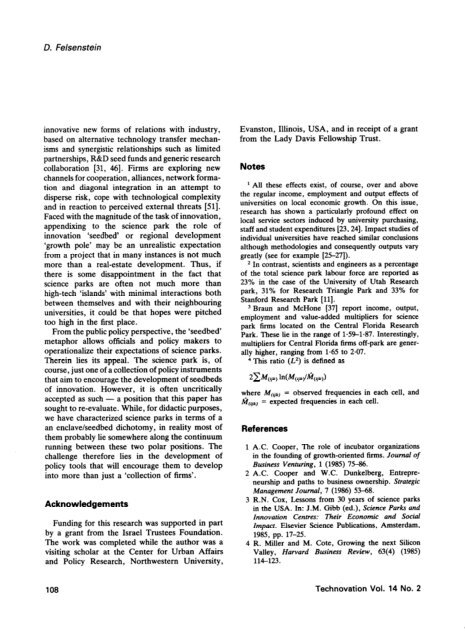University-related science parks - 'seedbeds' or 'enclaves' of ...
University-related science parks - 'seedbeds' or 'enclaves' of ...
University-related science parks - 'seedbeds' or 'enclaves' of ...
You also want an ePaper? Increase the reach of your titles
YUMPU automatically turns print PDFs into web optimized ePapers that Google loves.
D. Felsensteininnovative new f<strong>or</strong>ms <strong>of</strong> relations with industry,based on alternative technology transfer mechanismsand synergistic relationships such as limitedpartnerships, R&D seed funds and generic researchcollab<strong>or</strong>ation [31, 461. Firms are expl<strong>or</strong>ing newchannels f<strong>or</strong> cooperation, alliances, netw<strong>or</strong>k f<strong>or</strong>mationand diagonal integration in an attempt todisperse risk, cope with technological complexityand in reaction to perceived external threats [51].Faced with the magnitude <strong>of</strong> the task <strong>of</strong> innovation,appendixing to the <strong>science</strong> park the role <strong>of</strong>innovation ‘seedbed’ <strong>or</strong> regional development‘growth pole’ may be an unrealistic expectationfrom a project that in many instances is not muchm<strong>or</strong>e than a real-estate development. Thus, ifthere is some disappointment in the fact that<strong>science</strong> <strong>parks</strong> are <strong>of</strong>ten not much m<strong>or</strong>e thanhigh-tech ‘islands’ with minimal interactions bothbetween themselves and with their neighbouringuniversities, it could be that hopes were pitchedtoo high in the first place.From the public policy perspective, the ‘seedbed’metaph<strong>or</strong> allows <strong>of</strong>ficials and policy makers tooperationalize their expectations <strong>of</strong> <strong>science</strong> <strong>parks</strong>.Therein lies its appeal. The <strong>science</strong> park is, <strong>of</strong>course, just one <strong>of</strong> a collection <strong>of</strong> policy instrumentsthat aim to encourage the development <strong>of</strong> seedbeds<strong>of</strong> innovation. However, it is <strong>of</strong>ten uncriticallyaccepted as such - a position that this paper hassought to re-evaluate. While, f<strong>or</strong> didactic purposes,we have characterized <strong>science</strong> <strong>parks</strong> in terms <strong>of</strong> aan enclave/seedbed dichotomy, in reality most <strong>of</strong>them probably lie somewhere along the continuumrunning between these two polar positions. Thechallenge theref<strong>or</strong>e lies in the development <strong>of</strong>policy tools that will encourage them to developinto m<strong>or</strong>e than just a ‘collection <strong>of</strong> firms’.AcknowledgementsFunding f<strong>or</strong> this research was supp<strong>or</strong>ted in partby a grant from the Israel Trustees Foundation.The w<strong>or</strong>k was completed while the auth<strong>or</strong> was avisiting scholar at the Center f<strong>or</strong> Urban Affairsand Policy Research, N<strong>or</strong>thwestern <strong>University</strong>,Evanston, Illinois, USA, and in receipt <strong>of</strong> a grantfrom the Lady Davis Fellowship Trust.Notes’ All these effects exist, <strong>of</strong> course, over and abovethe regular income, employment and output effects <strong>of</strong>universities on local economic growth. On this issue,research has shown a particularly pr<strong>of</strong>ound effect onlocal service sect<strong>or</strong>s induced by university purchasing,staff and student expenditures [23,24]. Impact studies <strong>of</strong>individual universities have reached similar conclusionsalthough methodologies and consequently outputs varygreatly (see f<strong>or</strong> example [25-271).2 In contrast, scientists and engineers as a percentage<strong>of</strong> the total <strong>science</strong> park labour f<strong>or</strong>ce are rep<strong>or</strong>ted as23% in the case <strong>of</strong> the <strong>University</strong> <strong>of</strong> Utah Researchpark, 31% f<strong>or</strong> Research Triangle Park and 33% f<strong>or</strong>Stanf<strong>or</strong>d Research Park [ll].3 Braun and McHone [37] rep<strong>or</strong>t income, output,employment and value-added multipliers f<strong>or</strong> <strong>science</strong>park firms located on the Central Fl<strong>or</strong>ida ResearchPark. These lie in the range <strong>of</strong> 1~59-1~87. Interestingly,multipliers f<strong>or</strong> Central Fl<strong>or</strong>ida firms <strong>of</strong>f-park are generallyhigher, ranging from 1.65 to 2.07.4 This ratio (~5~) is defined aswhere h4, = observed frequencies in each cell, andticijkj = expected frequencies in each cell.ReferencesA.C. Cooper, The role <strong>of</strong> incubat<strong>or</strong> <strong>or</strong>ganizationsin the founding <strong>of</strong> growth-<strong>or</strong>iented firms. Journal <strong>of</strong>Business Venturing, 1 (1985) 75-86.A.C. Cooper and W.C. Dunkelberg, Entrepreneurshipand paths to business ownership. StrategicManagement Journal, 7 (1986) 53-68.R.N. Cox, Lessons from 30 years <strong>of</strong> <strong>science</strong> <strong>parks</strong>in the USA. In: J.M. Gibb (ed.), Science Parks andInnovation Centres: Their Economic and SocialImpact. Elsevier Science Publications, Amsterdam,1985, pp. 17-25.R. Miller and M. Cote, Growing the next SiliconValley, Harvard Business Review, 63(4) (1985)114-123.108Technovation Vol. 14 No. 2
















